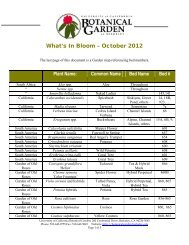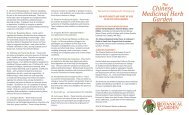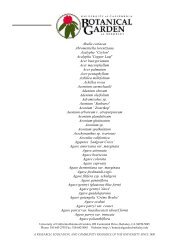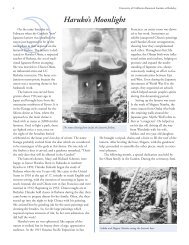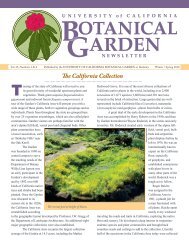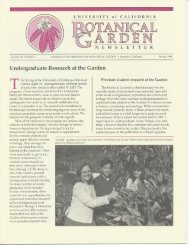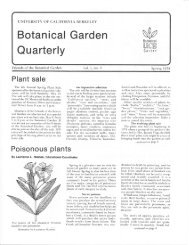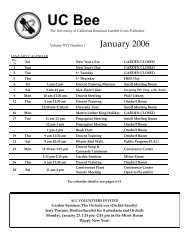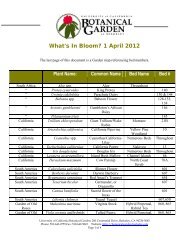UC Botanical Garden - The University of California Botanical Garden
UC Botanical Garden - The University of California Botanical Garden
UC Botanical Garden - The University of California Botanical Garden
Create successful ePaper yourself
Turn your PDF publications into a flip-book with our unique Google optimized e-Paper software.
<strong>UC</strong> <strong>Botanical</strong> <strong>Garden</strong><br />
A SELF-GUIDED FALL TOUR<br />
WELCOME to this seasonal tour <strong>of</strong> the <strong>UC</strong> <strong>Botanical</strong> <strong>Garden</strong>. <strong>The</strong> tour, which highlights a range <strong>of</strong> plants from<br />
around the world, is a circuit and takes about an hour. It starts in the Plaza at the <strong>Garden</strong> Entrance and ends at<br />
the Arid House. Look for the orange markers with white numbering to guide you to the featured plants.<br />
<strong>The</strong> Entrance Plaza has been planted with a stunning array <strong>of</strong> “water-wise” plants that immediately capture the eye<br />
with their fantastic forms, colors and shapes. <strong>The</strong> signboard located at the lower edge <strong>of</strong> the Plaza introduces these<br />
themes. Behind the sign is:<br />
1. ST CATHERINE’S LACE (Eriogonum giganteum). Native to the Channel Islands <strong>of</strong>f the southern coast <strong>of</strong><br />
<strong>California</strong>, this rare plant produces masses <strong>of</strong> pink and white flowers – providing nectar and pollen for both bees and<br />
butterflies. Even after full bloom is over the dry, lacy flower heads remain attractive. It is an example <strong>of</strong> “island<br />
gigantism” whereby plants and animals may evolve into larger species in the absence <strong>of</strong> predators. <strong>The</strong> Channel<br />
Islands have never been joined to the mainland and <strong>of</strong>fer a unique and diverse flora and fauna.<br />
Leave the Plaza and take the lower paved road to the <strong>California</strong> Area. Turn right and locate on your right at the<br />
Alpine Fell-Field:<br />
2. PARISH’S ERIOGONUM (Eriogonum parishii). This delightful low growing annual starts as a basal rosette <strong>of</strong><br />
leaves and then produces a flowering stalk that, in the fall, supports a pink/purple cloud <strong>of</strong> microscopic seed heads. It<br />
is native to dry gravelly places at an altitude <strong>of</strong> between 4,000 and 6,000 feet. Look in this bed for other species <strong>of</strong><br />
Eriogonum (commonly called buckwheat).<br />
Continue downhill and pause at the 2nd <strong>Garden</strong> bench on your right. Although autumn foliage displays are most<br />
flashy in the high mountains, these next two <strong>California</strong> natives, growing at low elevation, provide a seasonal color<br />
spot.<br />
3. WESTERN SPICEBUSH (Calycanthus occidentalis), and CALIFORNIA GRAPE (Vitis californica). Directly<br />
above the bench, the large, fragrant leaves <strong>of</strong> the western spicebush turn a glossy, golden yellow before falling to the<br />
ground. Further down the path, the spectacular golds and reds <strong>of</strong> the <strong>California</strong> grape provide a lovely waterfall <strong>of</strong><br />
color. Look closely and you may see clusters <strong>of</strong> tiny, green grapes that ripen to a deep wine-purple. <strong>The</strong> grape<br />
selection, ‘Roger’s Red’, is a particular favorite, as it was named in honor <strong>of</strong> former <strong>Garden</strong> horticulturist Roger<br />
Raiche. It is now know to be a hybrid between V. californica and a wine grape V. vinifera.<br />
Continue along the path and turn left into the Serpentine Area. Admire the deep greenish-silver coloration <strong>of</strong> the<br />
state rock <strong>of</strong> <strong>California</strong> and its unique associated flora. Look for the brochure explaining the geological and<br />
botanical features <strong>of</strong> this area. Leave the Serpentine Area, turning right, and make your way to the Channel<br />
Islands sign board. Go past the Hybrid Oak and turn right down the wooden steps (noticing on your left the<br />
particularly showy Eriogonum fasciculatum var. foliosum.) Cross the boardwalk over Strawberry Creek and go up<br />
to the Terrace <strong>of</strong> the Conference Center.<br />
4. WINDMILL PALM (Trachycarpus fortunei). This slow-growing elegant palm is ideal for a patio or terrace<br />
location. Its pleasing fan-shaped fronds require little maintenance and its roots are not invasive. Touch the coarse<br />
brown fiber covering the trunk. It feels like burlap sacking!
Cross the Terrace to your right and go down the concrete steps past the Tropical House. A brochure is available<br />
that highlights the treasures <strong>of</strong> this greenhouse. Follow the wooden steps up through the palms. On the other side<br />
<strong>of</strong> the paved road locate:<br />
5. EUONYMUS GRANDIFLORUS. This is also commonly known as a spindle tree. In Europe, the hard finegrained<br />
wood was used to carve spindles. In fall, the leaves <strong>of</strong> this semi-evergreeen shrub turn shades <strong>of</strong> scarlet, a<br />
perfect foil for the orange seeds splitting out <strong>of</strong> their yellow and pink fruit capsules. This particular example is a<br />
cutting from an original specimen collected in Bhutan in 1974.<br />
Turn right towards the Herb <strong>Garden</strong>. Growing out <strong>of</strong> the wall, look for the exotic purple and white flowers <strong>of</strong>:<br />
6. COMMON CAPER (Capparis spinosa). It is the immature bud <strong>of</strong> the caper that is pickled or preserved resulting<br />
in the tasty product beloved by gourmet cooks for sauces and garnishes. Originally, as was the case for many<br />
culinary herbs, the caper was used medicinally. This plant needs dry, extremely well drained, rocky soil to flourish.<br />
Continue on the main paved road uphill and turn right down the path at the Eastern North American Collection<br />
sign. On the left is a sprawling plant:<br />
7. SCARLET TRUMPET VINE (Campsis radicans). Do not plant this stunning vine if you have a small garden!<br />
It spreads rapidly by suckering roots and grows fast to 40 feet. It attaches to any support with its aerial rootlets,<br />
somewhat like ivy. <strong>The</strong> velvety scarlet flowers bloom in early fall. This east coast native is reminescent <strong>of</strong> the<br />
widely grown blood-red trumpet creeper, Distictis buccinatoria.<br />
Pass the picnic table and follow the steps down to:<br />
8. SWEET GUM (Liquidambar styraciflua). This tree yields a valuable timber and an aromatic resin. It is a<br />
popular street tree admired for its spectacular fall colors. Where do these colors come from As the days grow<br />
shorter, the tree begins to prepare for winter. Chlorophyll, the green color in the leaves, breaks down. <strong>The</strong><br />
remaining red and yellow pigments now show up strongly “in their true colors”! After a few weeks, the leaves dry<br />
out and fall to the ground.<br />
Ahead, you will find a selection <strong>of</strong> trees, including:<br />
9. GRAY BIRCH (Betula populifolia) and PAPER BIRCH (Betula papyrifera). <strong>The</strong>re are about 40 species <strong>of</strong><br />
birch worldwide. <strong>The</strong>ir most distinctive feature is their smooth pale bark, <strong>of</strong>ten peeling <strong>of</strong>f in long strips. <strong>The</strong> bark<br />
<strong>of</strong> each species is different and is a ready means <strong>of</strong> identification. Native Americans prefer the bark <strong>of</strong> the paper<br />
birch to make canoes and to cover lodges and tepees.<br />
Turn uphill to the left. At Bed 310 go up the wooden steps at the right fork. Join up with the main trail through the<br />
Mexico and Central American Area and turn right. On your right, by the sign, locate:<br />
10. WAX MALLOW (Malvaviscus mollis). This is a relative <strong>of</strong> the hibiscus and attracts hummingbirds.<br />
Medicinally, the leaves and flowers are boiled and drunk as a tea to treat coughs.<br />
Further along, on your right, look for a plant whose common name warns <strong>of</strong> its characteristics:<br />
11. MAL HOMBRE (Urera caracasana). DO NOT TO<strong>UC</strong>H this plant. This “BAD GUY” has stinging hairs that<br />
can cause irritation. Also known as scratch bush, it is in the nettle family. It has been reported as useful in treating<br />
the effects <strong>of</strong> poison ivy, in stopping nosebleeds and even curing syphilis.
Continue along this path, enjoying the views <strong>of</strong> the wooded canyon and, in the distance, San Francisco Bay. This is<br />
a favorite spot for hummingbirds attracted by the bright nectar-filled flowers <strong>of</strong> the various salvias and penstemons.<br />
On your right, opposite the massive Wigandia caracasana, in Bed 367, is:<br />
12. BOUVARDIA TERNIFOLIA. Growing in light shade, this shrubby plant produces intensely colored red bugle<br />
shaped flowers in summer and fall. Bouvardias are named for Dr. Charles Bouvard, physician to Louis XIII <strong>of</strong><br />
France in the 17th Century. He was also Superintendent <strong>of</strong> the Jardin des Plantes in Paris and carried out research on<br />
the medicinal uses <strong>of</strong> plants.<br />
Continue along this path for some 250 feet, it leads you out <strong>of</strong> the shade and into a brighter, dryer area. In Bed 375<br />
look for:<br />
13. MILKWEED (Asclepias elata). Milkweeds are so called because they bleed a white juice when broken. This<br />
juice contains latex and toxic alkaloids that act to deter attack by insects. Interestingly, larvae <strong>of</strong> the Monarch<br />
Butterfly choose the milkweed as their food plant and even incorporate some <strong>of</strong> the plant’s toxins into their bodies to<br />
provide protection from predators. <strong>The</strong> genus is named for Asclepius, the Greek god <strong>of</strong> healing, indicating that these<br />
plants were once important medicinally. In the fall they produce the unusual seedpods you will see here. <strong>The</strong>se<br />
contain silk or floss filaments attached to individual seeds. When ripe, the pods burst and the seeds are dispersed by<br />
the wind.<br />
Follow this path up the hill. On your right:<br />
14. AGAVE SP. It seems that all parts <strong>of</strong> the agave plant have a use! Agave syrup or nectar is a sweetener and a<br />
source <strong>of</strong> the distilled liquor tequila. <strong>The</strong> stringy fibers <strong>of</strong> the leaves produce sisal and other fibers, while the sharp<br />
tips and leaf edges may be used as rudimentary needles and nails. Agaves are also attractive landscaping plants and<br />
range from small, quite delicate types to this large eye-catching specimen - its flowering spikes dripping with nectar<br />
attract bees.<br />
At the top <strong>of</strong> this path you move into the South American Area <strong>of</strong> the garden. <strong>The</strong> intriguing scent may be traced to:<br />
15. BARRACO (Escallonia illinita). Are you reminded <strong>of</strong> maple syrup, peanut butter, or perhaps curry Resins in<br />
the leaves produce these scents. <strong>The</strong> plants make good windbreaks and are tolerant <strong>of</strong> salt spray, so would be<br />
optimal in seaside landscapes.<br />
At the next junction cross the road and enter the Crops <strong>of</strong> the World <strong>Garden</strong>. Enjoy a garden filled with<br />
agricultural crops displayed according to their continent <strong>of</strong> origin. Look carefully at the labels – you may be<br />
surprised!<br />
Walk through this area and out onto the main paved road. Turn left, downhill and pause half-way down. Notice on<br />
your left:<br />
16. EASTERN NORTH AMERICAN AREA. Here you will find brilliant masses <strong>of</strong> late summer-early fall<br />
flowers from “back East”. Look for asters, rudbeckias, the towering joe-pye weed.<br />
Turn right <strong>of</strong>f the main paved road into the Chinese Medicinal Herb <strong>Garden</strong>. You will notice additional plant<br />
labels here that refer to the medicinal properties <strong>of</strong> various plant parts. On your left by #11 “Astringent Herbs”,<br />
look up at the leaves, which turn butter-yellow in Fall, <strong>of</strong>:
17. GINGKO or MAIDENHAIR TREE (Ginkgo biloba). Besides being native to China, fossil remains show that<br />
the ginkgo occurred in <strong>California</strong> millions <strong>of</strong> years ago. This tree belongs to a group <strong>of</strong> plants called gymnosperms,<br />
which includes conifers and cycads. It has a rather unique set <strong>of</strong> reproductive structures and has separate male and<br />
female trees. Female trees produce “ginkgo nuts” which, when cleaned and roasted, are valued as a digestive aid.<br />
Ginkgo Biloba Extract (GBE), made from the leaves, is an extremely popular natural remedy for memory problems.<br />
At the ornamental bridge turn right towards the lawn and large commemorative stone. Locate:<br />
18. CHRYSANTHEMUM (Chrysanthemum indicum). Chinese gardeners regard the chrysanthemum as one <strong>of</strong> the<br />
“four noble plants” – the others being the orchid, the bamboo and the plum. <strong>The</strong>se fall-blooming flowers symbolize<br />
the idealized life <strong>of</strong> the scholar in retirement and are the subject <strong>of</strong> many famous poems and paintings.<br />
Chrysanthemums are “short day” plants and bloom late in the season as the days shorten. You may notice some<br />
spring-flowering plants responding to the shorter days as well. Look at the neighboring Magnolia liliiflora.<br />
Follow this path along the top <strong>of</strong> the lawn to the end and into the shady Asian Area, with Bed 500 on your right.<br />
Turn left when you reach the ivy-cloaked Coast Redwood (Sequoia sempervirens). Along this path admire the<br />
striking blue flowers <strong>of</strong>:<br />
19. CHINESE PLUMBAGO (Ceratostigma willmottianum). As the season progresses the foliage <strong>of</strong> this plant<br />
takes on an attractive red color. It is named for Ellen Ann Willmott, an English gardener and rose lover. She<br />
reputedly secretly scattered the seeds <strong>of</strong> another plant, Eryngium giganteum (henceforth known as “Miss Willmott’s<br />
Ghost”) in many <strong>of</strong> the famous gardens she visited!<br />
Turn right at the intersection and then left down the steps under the majestic branches <strong>of</strong> the Stranvaesia davidiana.<br />
Continue along the path, down several steps and turn right by the tall stump <strong>of</strong> another Coast Redwood. Growing<br />
around the benches locate a group <strong>of</strong> five trees:<br />
20. DAWN REDWOOD (Metasequoia glyptostroboides). <strong>The</strong>se trees are the result <strong>of</strong> an historic collecting<br />
expedition to China in 1947 when it was discovered that this tree, formerly believed to be extinct, was in fact still in<br />
existence. <strong>The</strong> Chinese name “water fir” indicates a preference for damp locations. <strong>The</strong> Dawn Redwood is<br />
deciduous. In late fall the leaves turn bronze-colored and then fall <strong>of</strong>f as winter arrives. In the spring, delicate pale<br />
green foliage announces the growing season.<br />
Cross the creek at the stepping-stones and turn right up the narrow trail following the creek upstream. Climb the<br />
stone steps and turn left. At the intersection make a sharp right turn up the steps. Continue up towards the waterfall<br />
and the Japanese Pool. Featured around the pool (but not individually numbered for this tour to preserve the<br />
beauty <strong>of</strong> the scene):<br />
21. KOREAN MAPLE (Acer pseudo-sieboldianum), JAPANESE MAPLE (Acer palmatum), ACER MONO,<br />
ACER HENRYI and ACER CISSIFOLIUM. Although best known for their fall color, these trees delight at any<br />
season. Tender buds and spring foliage are <strong>of</strong>ten brightly colored too, while flowers are usually white, red or pink.<br />
In summer, the distinctively cut and lobed leaves provide a s<strong>of</strong>t shady canopy. <strong>The</strong> <strong>Garden</strong>’s collection <strong>of</strong> maples<br />
also includes species with the less commonly seen trifoliate or even simple leaf shape. Bare branches in winter<br />
create artistic shapes in the landscape, and the bark <strong>of</strong> some species is attractively colored. <strong>The</strong> fruit, a pair <strong>of</strong> longwinged<br />
samara, may also be brightly colored.<br />
Turn left and follow the path through the Japanese Gate. On the left, look for another special maple:
22. MAPLE (Acer sieboldianum). This tree from Japan is another example <strong>of</strong> the more than 35 different maple<br />
species found throughout the <strong>Garden</strong>’s Asian collection. <strong>The</strong> Japanese Gate honors Chuira and Haruko Obata.<br />
Pr<strong>of</strong>essor Obata was the first Japanese-American hired in the <strong>UC</strong> Berkeley Art Department and was renowned for<br />
his evocative landscape paintings. Planted nearby is a camellia, Haruko Obata’s favorite flower for use in her<br />
traditional Ikebana flower arrangements.<br />
Continue to the main paved road and turn left. On the left <strong>of</strong> the road, down slope, you will see a landscape<br />
dominated by the sculptural shapes <strong>of</strong> the cacti and succulents <strong>of</strong> the New World Desert. Plantings on the right,<br />
upslope, are native to Southern Africa. Before you reach the large greenhouse (the Arid House) turn right up the<br />
path to:<br />
23. TREE GRAPE (Cyphostemma juttae). Native to Namibia where it grows in an extremely dry environment, this<br />
plant stores water in its swollen trunk and fleshy leaves. Its pale bark also helps to keep it cool. It produces<br />
inconspicuous flowers which mature into grape-like bunches <strong>of</strong> bright (inedible) berries. To see more marvelous<br />
botanical adaptations to harsh dry environments around the world, take a few moments to explore the wonders <strong>of</strong> the<br />
adjacent Arid House. Wicked thorns, strangely contorted plant forms and surprisingly colorful blooms combine to<br />
make this a fascinating experience.<br />
Exit the Arid House into the Entrance Plaza. We hope you have enjoyed this seasonal walk through the <strong>Garden</strong>.<br />
Check the Plant Sales Area and the <strong>Garden</strong> Shop for unusual and collectible plants, books and gifts.<br />
<strong>University</strong> <strong>of</strong> <strong>California</strong> <strong>Botanical</strong> <strong>Garden</strong><br />
200 Centennial Drive, #5045<br />
Berkeley, <strong>California</strong> 94720-5045<br />
Website: http://botanicalgarden.berkeley.edu<br />
© 2010 <strong>The</strong> Regents <strong>of</strong> the <strong>University</strong> <strong>of</strong> <strong>California</strong>





